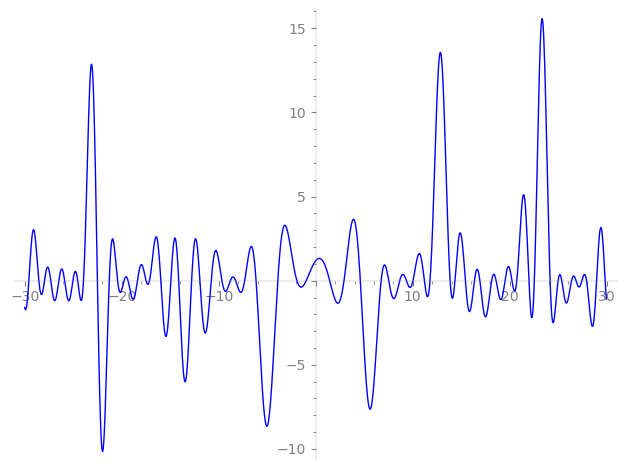| L(s) = 1 | − 4.62·2-s + (4.25 − 2.98i)3-s + 13.4·4-s − 5.89i·5-s + (−19.6 + 13.7i)6-s + 10.0·7-s − 25.0·8-s + (9.22 − 25.3i)9-s + 27.2i·10-s + 53.2·11-s + (57.0 − 39.9i)12-s − 28.7i·13-s − 46.7·14-s + (−17.5 − 25.0i)15-s + 8.64·16-s + 131. i·17-s + ⋯ |
| L(s) = 1 | − 1.63·2-s + (0.819 − 0.573i)3-s + 1.67·4-s − 0.527i·5-s + (−1.34 + 0.938i)6-s + 0.545·7-s − 1.10·8-s + (0.341 − 0.939i)9-s + 0.862i·10-s + 1.46·11-s + (1.37 − 0.962i)12-s − 0.613i·13-s − 0.891·14-s + (−0.302 − 0.431i)15-s + 0.135·16-s + 1.87i·17-s + ⋯ |
\[\begin{aligned}\Lambda(s)=\mathstrut & 177 ^{s/2} \, \Gamma_{\C}(s) \, L(s)\cr =\mathstrut & (0.339 + 0.940i)\, \overline{\Lambda}(4-s) \end{aligned}\]
\[\begin{aligned}\Lambda(s)=\mathstrut & 177 ^{s/2} \, \Gamma_{\C}(s+3/2) \, L(s)\cr =\mathstrut & (0.339 + 0.940i)\, \overline{\Lambda}(1-s) \end{aligned}\]
Particular Values
| \(L(2)\) |
\(\approx\) |
\(0.968634 - 0.680440i\) |
| \(L(\frac12)\) |
\(\approx\) |
\(0.968634 - 0.680440i\) |
| \(L(\frac{5}{2})\) |
|
not available |
| \(L(1)\) |
|
not available |
\(L(s) = \displaystyle \prod_{p} F_p(p^{-s})^{-1} \)
| $p$ | $F_p(T)$ |
|---|
| bad | 3 | \( 1 + (-4.25 + 2.98i)T \) |
| 59 | \( 1 + (118. - 437. i)T \) |
| good | 2 | \( 1 + 4.62T + 8T^{2} \) |
| 5 | \( 1 + 5.89iT - 125T^{2} \) |
| 7 | \( 1 - 10.0T + 343T^{2} \) |
| 11 | \( 1 - 53.2T + 1.33e3T^{2} \) |
| 13 | \( 1 + 28.7iT - 2.19e3T^{2} \) |
| 17 | \( 1 - 131. iT - 4.91e3T^{2} \) |
| 19 | \( 1 - 46.0T + 6.85e3T^{2} \) |
| 23 | \( 1 + 74.5T + 1.21e4T^{2} \) |
| 29 | \( 1 + 76.0iT - 2.43e4T^{2} \) |
| 31 | \( 1 + 6.76iT - 2.97e4T^{2} \) |
| 37 | \( 1 + 329. iT - 5.06e4T^{2} \) |
| 41 | \( 1 + 319. iT - 6.89e4T^{2} \) |
| 43 | \( 1 - 116. iT - 7.95e4T^{2} \) |
| 47 | \( 1 - 301.T + 1.03e5T^{2} \) |
| 53 | \( 1 + 314. iT - 1.48e5T^{2} \) |
| 61 | \( 1 + 559. iT - 2.26e5T^{2} \) |
| 67 | \( 1 - 221. iT - 3.00e5T^{2} \) |
| 71 | \( 1 + 250. iT - 3.57e5T^{2} \) |
| 73 | \( 1 - 450. iT - 3.89e5T^{2} \) |
| 79 | \( 1 + 403.T + 4.93e5T^{2} \) |
| 83 | \( 1 - 341.T + 5.71e5T^{2} \) |
| 89 | \( 1 + 1.52e3T + 7.04e5T^{2} \) |
| 97 | \( 1 - 1.03e3iT - 9.12e5T^{2} \) |
| show more | |
| show less | |
\(L(s) = \displaystyle\prod_p \ \prod_{j=1}^{2} (1 - \alpha_{j,p}\, p^{-s})^{-1}\)
Imaginary part of the first few zeros on the critical line
−11.93697105007615644883409761110, −10.77379810520497742129078891760, −9.672684264262507569689228026626, −8.800532284215220250134927815277, −8.253484010269676327210680201866, −7.32189490670501766645456440729, −6.14943222938231244078363754285, −3.91157053595321337311558239185, −1.93557885540029361679834063750, −0.983626552312611459623385282495,
1.44026525430098441267461501922, 2.91580503878737083058285378886, 4.59756897628590931640189141155, 6.74334237551575510479538551863, 7.52814835278418251367879987508, 8.656495940254029611428942080807, 9.348687450956500813790990342884, 10.02621681389746382541355229240, 11.19887719640668365496553303148, 11.77915763970598082051186678973

